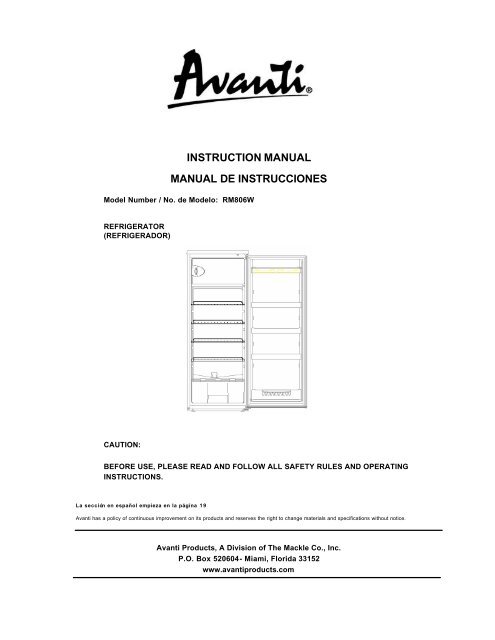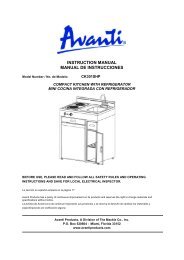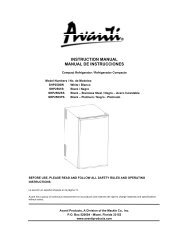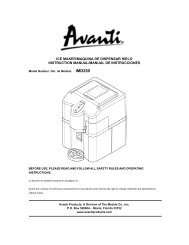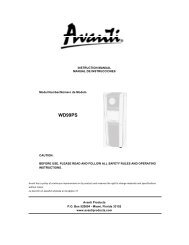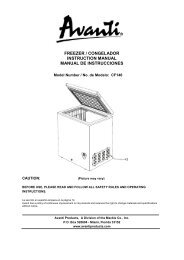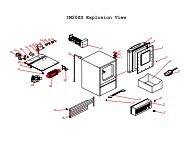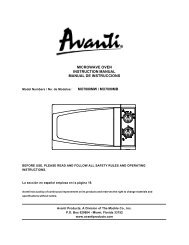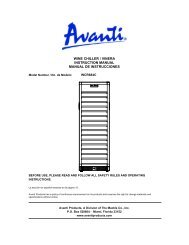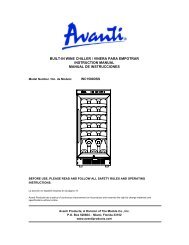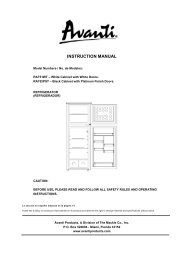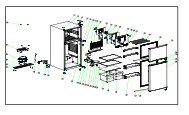instruction manual manual de instrucciones - Avanti Products
instruction manual manual de instrucciones - Avanti Products
instruction manual manual de instrucciones - Avanti Products
- No tags were found...
Create successful ePaper yourself
Turn your PDF publications into a flip-book with our unique Google optimized e-Paper software.
INSTRUCTION MANUALMANUAL DE INSTRUCCIONESMo<strong>de</strong>l Number / No. <strong>de</strong> Mo<strong>de</strong>lo: RM806WREFRIGERATOR(REFRIGERADOR)CAUTION:BEFORE USE, PLEASE READ AND FOLLOW ALL SAFETY RULES AND OPERATINGINSTRUCTIONS.La sección en español empieza en la págína 19<strong>Avanti</strong> has a policy of continuous improvement on its products and reserves the right to change materials and specifications without notice.<strong>Avanti</strong> <strong>Products</strong>, A Division of The Mackle Co., Inc.P.O. Box 520604 - Miami, Florida 33152www.avantiproducts.com
REFRIGERATOR SAFETYYour safety and the safety of others are very important.We have provi<strong>de</strong>d many important safety messages in this <strong>manual</strong> for your appliance. Always readand obey all safety messages.This is the Safety Alert Symbol. This symbol alerts you to potential hazards thatcan kill or injure you and others. All safety messages will follow the SafetyAlert Symbol and either the words” DANGER”, “WARNING” or “CAUTION”.Danger means that failure to heed thissafety statement may result in severepersonal injury or <strong>de</strong>ath.Warning means that failure to heed thissafety statement may result in extensiveproduct damage, serious personal injury, or<strong>de</strong>ath.Caution means that failure to heed thissafety statement may result in minor ormo<strong>de</strong>rate personal injury, property orequipment damage.All safety messages will alert you to know what potential hazard is, tell you how to reduce the chanceof injury, and let you know what can happen if the <strong>instruction</strong>s are not followed.3
IMPORTANT SAFEGUIDESBefore the refrigerator is used, it must be properly positioned and installed as<strong>de</strong>scribed in t his <strong>manual</strong>,so read the <strong>manual</strong> carefully. To reduce the risk of fire,electrical shock or injury when using the refrigerator, follow basic precaution,including the following:? Plug into a groun<strong>de</strong>d 3 -prong outlet, do not remove grounding prong, do not use an adapter, anddo not use an extension cord.? It is recommen<strong>de</strong>d that a separate circuit, serving only your refrigerator be provi<strong>de</strong>d. Usereceptacles that cannot be turned off by a switch or pull chain.? Never clean refrigerator parts with flammable fluids. These fumes can create a fire hazard o rexplosion. And do not store or use gasoline or other flammable vapors and liquids in the vicinity ofthis or any other appliance. The fumes can create a fire hazard or explosion.? Before proceeding with cleaning and maintenance operations, make sure the power line of theunit is disconnected.? Do not connect or disconnect the electric plug when your hands are wet.? Unplug the refrigerator or disconnect power before cleaning or servicing. Failure to do so canresult in electrical shock or <strong>de</strong>ath.? Do not attempt to repair or replace any part of your refrigerator unless it is specificallyrecommen<strong>de</strong>d in this <strong>manual</strong>. All other servicing should be referred to a qualified technician.FOLLOW WARNING CALL OUTS BELOW ONLY WHEN APPLICABLE TO YOUR MODEL? Use two or more people to move and install refrigerator. Failure to do so can result in back orother injury.? To ensure proper ventilation for your refrigerator, the front of the unit must be completelyunobstructed. Choose a well-ventilated area with temperatures above 60°F (16 ° C) and below90°F (32°C). This unit must be installed in an area protected from the element, such as wind, rain,water spray or drips.? The refrigerator should not be located next to ovens, grills or other sources of high heat.? The refrigerator must be installed with all electrical, water and drain connections in accordancewith state and local co<strong>de</strong>s. A standard electrical supply (115 V AC only, 60 Hz), properlygroun<strong>de</strong>d in accordance with the National Electrical Co<strong>de</strong> and local co<strong>de</strong>s and ordinances isrequired.? Do not kink or pinch the power supply cord of refrigerator.? The fuse (or circuit breaker) size should be 15 amperes.? It is important for the refrigerator to be leveled in or<strong>de</strong>r to work properly. You may need to makeseveral adjustments to level it.? All installation must be in accordance with local plumbing co<strong>de</strong> requirements.? Make certain that the pipes are not pinched or kinked or damaged during installations .? Check for leaks after connection.? Never allow children to operate, play with or crawl insi<strong>de</strong> the refrigerator.? Although the unit has been tested at the factory, due to long-term transit and storage, the firstbatch of cubes must be discar<strong>de</strong>d.? Do not use solvent-based cleaning agents of abrasives on the interior. These cleaners maydamage or discolor the interior.? Do not use this apparatus for other than its inte n<strong>de</strong>d purpose.4
Registration Information? Protect your product:We will keep the mo<strong>de</strong>l number and date of purchase of your new <strong>Avanti</strong> product on file tohelp you refer to this information in the event of an insurance claim such as fire or theft.? Promote better products:We value your input. Your responses will help us <strong>de</strong>velop products <strong>de</strong>signed to best meetyour future needs.--------------------------------------------------------- (Detach Here)----------------------------------------------------------<strong>Avanti</strong> Registration Card__________________________________ _____________________________________Name Mo<strong>de</strong>l # Serial #__________________________________ _____________________________________Address Date Purchased Store/Dealer Name__________________________________ ______________________________________City State Zip Occupation__________________________________ As Your Primary Resi<strong>de</strong>nce, Do You:Area Co<strong>de</strong> Phone Number ?Own ?RentDid You Purchase An Additional Warranty: Your Age:?Exten<strong>de</strong>d ?Food Loss ?None ?un<strong>de</strong>r 18 ?18-25 ?26-30Reason For Choosing This <strong>Avanti</strong> Product: ?31-35 ?36-50 ?over 50Please indicate the most important factors Marital Status:that influenced your <strong>de</strong>cision to purchase ?Married ?Singlethis product.Is This Product Used In The:?Price ?Home ?Business?Product FeaturesHow Did You Learn About This Product:?<strong>Avanti</strong> Reputation ?Advertising ?Product Features?Product Quality ?In Store Demo ?Personal Demo?Salesperson Recommendation?Other______________________________?Friend/Relative RecommendationComments____________________________?Warranty_____________________________________?Other____________________________________________________________5
PARTS & FEATURES712839410561 Freezer Compartment2 Temperature Control and Light3 Refrigerator Glass Shelves (4)4 Glass Crisper Cover5 Vegetable Crisper6 Leveling Legs (2)7 Egg Trays (2)8 Door Bins (4)9 Bottle Retainer10 Bottle Door Bin8
Table of ContentsRefrigerator Safety 3Important Safegui<strong>de</strong>s 4Registration Information and Registration Card 5Help Us Help You 7Parts and Features 8Important Safety Instructions 10Installation Instructions 10Before Using Your Appliance 10Installation of Your Appliance 10Electrical Connection 11Reversing the Door Swing of Your Appliance 11Operating Your Appliance 11Temperature Control 11Interior Light 11Defrosting Your Appliance 12Using Your Ice Cube Trays 12The Freezer Compartment 12Care and Maintenance 13Cleaning Your Appliance 13Maintenance of Your Appliance 13Changing the Light Bulb 13Moving Your Appliance 13Energy Saving Tips 14Troubleshooting Gui<strong>de</strong> 15Service for Your Appliance 16Your <strong>Avanti</strong> <strong>Products</strong> Warranty 17Wiring Diagram 18Instrucciones en Español 19 - 249
Important Safety Instructions?WARNING?To reduce the risk of fire, electrical shock,or injury when using your appliance, followthese basic precautions:? Read all <strong>instruction</strong>s before using the appliance.? DANGER or WARNING: Risk of child entrapment.? Child entrapment and suffocation are not problems of the past. Junked orabandoned appliances are still dangerous. . . even if they will “just sit in the garage afew days.”? Before you throw away your old refrigerator or freezer: Take off the doors.Leave the shelves in place so that children may not easily climb insi<strong>de</strong>.? Never allow children to operate, play with, or crawl insi<strong>de</strong> the appliance.? Never clean appliance parts with flammable fluids. The fumes can create a firehazard or explosion.? Do not store or use gasoline or any other flammable vapors and liquids in the vicinityof this or any other appliance. The fumes can create a fire hazard or explosion.-Save these <strong>instruction</strong>s-INSTALLATION INSTRUCTIONS? Before Using Your Appliance? Remove the exterior and interior packing.? Check to be sure you have all of the following parts:? 1 Ice Cube Tray? 1 Plastic Scraper? 5 Door Bins? 4 Refrigerator Glass shelves? 1 Crisper? 1 Glass Crisper Cover? 1 Bottle Retainer? 2 Egg Trays? Instruction Manual? Before connecting the appliance to the power source, let it stand upright for approximately 2hours. This will reduce the possibility of a malfunction in the cooling system from handlingduring transportation.? Clean the interior surface with lukewarm water using a soft cloth.? In case the interior accessories are not correctly placed, rearrange them as <strong>de</strong>scribed inchapter “Parts and Features”? Installation of Your Appliance? Place your appliance on a floor that is strong enough to support the appliance when it is fullyloa<strong>de</strong>d. To level your appliance, adjust the legs at the front of the appliance.? Allow 5 inches of space between the back and si<strong>de</strong>s of the appliance, which allows the properair circulation to cool the compressor.? Locate the appliance away from direct sunlight and sources of heat (stove, heater, radiator,etc.). Direct sunlight may affect the acrylic coating and heat sources may increase electricalconsumption. Extreme cold ambient temperatures may also cause the appliance not toperform properly.? Avoid locating the appliance in moist areas. Too much moisture in the air will cause frost toform quickly on the evaporator requiring more frequent <strong>de</strong>frosting of the appliance.10
? Electrical Connection?Warning?Improper use of the groun<strong>de</strong>d plug can result in the risk of electrical shock. If the power cord isdamaged, have it replaced by an authorized <strong>Avanti</strong> <strong>Products</strong> service center.This appliance should be properly groun<strong>de</strong>d for your safety. The power cord of this applianceis equipped with a three-prong plug which mates with standard three prong wall outlets tominimize the possibility of electrical shock.Do not un<strong>de</strong>r any circumstances cut or remove the third ground prong from the power cordsupplied.Plug the appliance into an exclusive properly installed-groun<strong>de</strong>d wall outlet. Do not un<strong>de</strong>r anycircumstances cut or remove the third (ground) prong from the power cord. Any questionsconcerning power and or grounding should be directed toward a certified electrician or anauthorized <strong>Avanti</strong> <strong>Products</strong> service center.Use of extension cords is not recommen<strong>de</strong>d.This appliance requires a standard 115/120-volt, 60Hz electrical outlet with three-prongground.The cord should be secured behind the appliance and not left exposed or dangling to preventacci<strong>de</strong>ntal injury.? Reversing the Door Swing of Your ApplianceThis appliance has the capability of either opening the door from the left or right si<strong>de</strong>.The unit is <strong>de</strong>livered to you with the door opening from the left si<strong>de</strong>. Should you <strong>de</strong>sireto reverse the opening direction, please call customer service for reversal <strong>instruction</strong>s.OPERATING YOUR APPLIANCE? Temperature Control? Your appliance has only one control for regulating thetemperature in the fresh food and the freezer compartment.The temperature control is located on the upper right handsi<strong>de</strong> of the fresh food section.? The range of the temperature control is from position" 0" thewarmest to "5" the col<strong>de</strong>st.? The first time you turn the unit on set the temperature controlto “5” or the max-position.? After 24 to 48 hours, adjust the temperature control to the setting that best suites your needs.The setting of “3” should be correct for home or office appliance use.? Changes of the ambient temperature affect temperature in the interior of the appliance(choose correct setting of the thermostat knob).? To turn the thermostat off, turn the temperature control to "0".NOTE:? Turning the temperature control to "0" position stops the cooling cycle but does not shutoff the power to the appliance.? If the unit is unplugged, power lost, or turned off; you must wait 3 to 5 minutes beforerestarting the unit. If you attempt to restart before this time <strong>de</strong>lay, the appliance will notstart.? Interior LightWhen you open the door the light will be ON automatically. When you close the door thelight will turn OFF automatically.11
? Defrosting Your Appliance? When? For the most efficient operation and minimum energy consumption, <strong>de</strong>frost theappliance compartment when the frost on the appliance walls is excessive or ¼ inch thick.There is no need to <strong>de</strong>frost the refrigerator, because ice <strong>de</strong>positing on the inner back wall is<strong>de</strong>frosted automatically. Ice is <strong>de</strong>positing on the inner back wall during the compressoroperation; later on, when the compressor is not operating ice is <strong>de</strong>frosting and water dropscollect and drain through the outlet in the inner back wall into the drain pan situated above thecompressor, from where it evaporates.CAUTIONDo not use boiling water because it may damage the plastic parts. In addition, neveruse a sharp or metallic instrument to remove frost as it may damage the cooling coilsand will void the warranty. We recommend using the plastic scraper.? A few hours before <strong>de</strong>frosting set the thermostat to position 5, so foods are well frozen.? Reset the thermostat to 0 position and disconnect the power supply.? Remove the frozen food from the appliance and place it in a cooler to protect the food.? Leave the door open for a while so that you can easy scrape off the frost.? Use a plastic scraper but be careful not to damage the inner surfaces of the freezer.? Wipe up the scraped frost and ice before it is completely <strong>de</strong>frosted.? Using Your Ice Cube Trays? Recommen<strong>de</strong>d thermostat setting for ice making is position 5.? Fill the ice cube tray (two thirds of it) with cold water or with any liquidsuitable for freezing and place the tray on the bottom of the freezer tofreeze properly.? Dry the tray, otherwise it may stick to the bottom of the freezer.? The best method to get ice cubes out of the tray is to hold the trayun<strong>de</strong>r cold tap water for a second.? To eject the ice cubes from the trays, place over the ice bucket and twist slightly? Freezing Fresh Foods? Proper use of the appliance, a<strong>de</strong>quately packed food, correct temperature and taking intoaccount hygienic precautions will substantially influence the quality of freezing the food orstoring of the frozen foods.? Carefully select food you intend to freeze; it should be of a<strong>de</strong>quate quality and suitable forfreezing.? Use correct packaging and wrap it right.? The packaging should be airtight and shouldn’t leak since this could cause substantial vitaminloss and <strong>de</strong>hydration of foods.? Foils and bags should be soft enough to tightly wrap around the foods.? When preparing foods to be frozen, consi<strong>de</strong>r sanitary precautions.? Mark packages with following data: kind and amount of foods and the date of loading.? It is most Important that the food is frozen as quickly as possible.? If the loading amount is too large, the quality of freezing is reduced which affects the quality offrozen foods.? The next time you want to freeze fresh foods, repeat the freezing procedure and be carefulthat packages with fresh foods do not touch frozen pac kages.? For freezing smaller amount of foods (up to 2 lbs.) there is no need to change the thermostatsetting.12
CARE AND MAINTENANCE? Cleaning Your Appliance? Turn the temperature control to "0", unplug the appliance, and remove the food, shelves, andtrays.? Wash the insi<strong>de</strong> with warm water and baking soda solution. The solution should be about 2tablespoons of baking soda to a quart of water.? Wash the shelves and trays with a mild <strong>de</strong>tergent solution. Plastic parts cannot be washed ina dishwasher.? The outsi<strong>de</strong> of the appliance should be cleaned with mild <strong>de</strong>tergent and warm water.? The con<strong>de</strong>nser coils should be vacuumed when they are dusty or dirty.? Clean the drain pan on the refrigerator compressor. Do not remove the drain pan.? After cleaning, connect the a ppliance to power supply and reload the packages.? Maintenance of Your Appliance? Changing the Light Bulb? Unplug the AC power cord from the wall.? Remove the screw with a Phillips screwdriver.? Remove the light bulb cover.? Remove the bulb.? Replace with a 10 watts bulb that is the same shapeand size.? Replace the light bulb cover and tighten screw.? Power FailureMost power failures are corrected within a few hours and should not affect thetemperature of your appliance if you minimize the number of times the door is opened. Ifthe power is going to be off for a longer period of time, you need to take the proper stepsto protect your food.? Vacation TimeDuring long absences, remove all the food; unplug your appliance, clean your appliance, andleave the doo r slightly open to avoid possible formation of con<strong>de</strong>nsation, mold, or odors.? Moving Your Appliance? Remove all the food.? Securely tape down all loose items insi<strong>de</strong> your appliance.? Turn the leveling screws up to the base to avoid damage.? Tape the doors shut.? Be sure the appliance stays in the upright position during transportation.13
? Energy Saving Tips? The appliance should be located in the coolest area of the room, away from heat producingappliances or heating ducts, and out of the direct sunlight.? Let hot foods cool to room temperature before placing in the appliance. Overloading theappliance forces the compressor to run longer. Foods that freeze too slowly may lose quality, orspoil.? Be sure to wrap foods properly, and wipe containers dry before placing them in the appliance.This cuts down on frost build-up insi<strong>de</strong> the appliance.? Appliance storage bin should not be lined with aluminum foil, wax paper, or paper toweling.Liners interfere with cold air circulation, making the appliance less efficient.? Organize and label food to reduce door openings and exten<strong>de</strong>d searches. Remove as manyitems as nee<strong>de</strong>d at one time, and close the door as soon as possible.? Try not to open the door too often, especially when the weather is wet and hot.? Every so often check i f the appliance is sufficiently ventilated.? Ice and frost layer increase energy consumption, so clean the appliance as soon as the layer is¼” thick.14
PROBLEMS WITH YOUR APPLIANCE?You can solve many common appliance problems easily, saving you the cost of a possible servicecall. Try the suggestions below to see if you can solve the problem before calling the servicer.TROUBLESHOOTING GUIDEPROBLEMPOSSIBLE CAUSEAppliance does not operate.Not plugged in.The circuit breaker tripped or blown fuse.Compressor turns on and off frequently.Con<strong>de</strong>nser coil at the back of the unit is dirty.The room temperature is hotter than normal.A large amount of food has been ad<strong>de</strong>d to theappliance.The door is open too often.The door is not closed completely.The temperature control is not set correctly.The door gasket does not seal properly.The appliance does not have the correctclearances. (5” at both si<strong>de</strong> and the back of unit)The light does not work.The home circuit breaker or fuse has tripped.The appliance is unplugged.The bulb has burned out (see the maintenancesection for the replacement procedure).Vibrations.Check to assure that the appliance is level.The appliance seems to make too much noise. The rattling noise may come from the flow of therefrigerant, which is normal.As each cycle ends, you may hear gurglingsounds caused by the flow of refrigerant in yourappliance.Contraction and expansion of the insi<strong>de</strong> wallsmay cause popping and crackling noises.The appliance is not level.The door will not close properly.The appliance is not level.The doors were reversed and not properlyinstalled.The gasket is dirty.The shelves, bins, or baskets are out of position.15
SERVICE FOR YOUR APPLIANCEWe are proud of our customer service organization and the network of professional servicetechnicians that provi<strong>de</strong> service on your <strong>Avanti</strong> appliances. With the purchase of your <strong>Avanti</strong>appliance, you can have the confi<strong>de</strong>nce that if you ever nee d additional information or assistance, the<strong>Avanti</strong> <strong>Products</strong> Customer Service team will be here for you. Just call us toll-free.Product Information800-323-5029Part Or<strong>de</strong>rs800-220-5570In-Home Repair Service800-220-5570AVANTI PRODUCTS CUSTOMER SERVICESWhatever your questions are about our products,help is available.You may or<strong>de</strong>r parts and accessories that will be<strong>de</strong>livered directly to your home.You may or<strong>de</strong>r these items by personal check,money or<strong>de</strong>r, Master Card, or Visa.An <strong>Avanti</strong> <strong>Products</strong> authorized service center willprovi<strong>de</strong> expert repair service, scheduled at a timethat is convenient for you. Our trained servicersknow your appliance insi<strong>de</strong> and out.16
YOUR <strong>Avanti</strong> <strong>Products</strong> WARRANTYWHAT IS COVEREDLIMITED ONE-YEARWARRANTYFor one year from the date ofpurchase by the original owner, <strong>Avanti</strong><strong>Products</strong> will, at its option, repair orreplace any part of the appliancewhich proves to be <strong>de</strong>fective inmaterial or workmanship un<strong>de</strong>r normaluse. During this period <strong>Avanti</strong><strong>Products</strong> will provi<strong>de</strong> all parts andlabor necessary to correct such<strong>de</strong>fects free of charge, so long as theappliance has been installed andoperated in accordance with thewritten <strong>instruction</strong>s in this <strong>manual</strong>. Inrental or commercial use, the warrantyperiod is 90 days. All <strong>Avanti</strong>appliances of 3.5 cubic foot capacityor less must be brought/sent to theapplicable service shop for repair.Staple your sales receipt here. Proof oforiginal purchase date is nee<strong>de</strong>d to obtainservice un<strong>de</strong>r warranty.LIMITED SECOND THROUGHFIFTH YEAR WARRANTYFor the second through the fifth year from dateof original purchase, <strong>Avanti</strong> <strong>Products</strong> willprovi<strong>de</strong> a replacement compressor free ofcharge due to a failure. You are responsiblefor the service labor and freight charges. Inrental or commercial use, the limitedcompressor warranty is one year and ninemonths. Cost to move the appliance to theservicers’ shop and back to the user's home,as may be required, are the user'sresponsibility.WHAT IS NOT COVERED? Content losses of food due to spoilage.? Inci<strong>de</strong>ntal or consequential damages.? Parts and labor costs for the following willnot be consi<strong>de</strong>red as warranty:? Evaporator doors, door springs, and/orframes.? Inner door panels, door shelves, doorrails, and/or door supports.? Chest appliance lid liners.? Vegetable crispers.? Light bulbs and/or plastic housing.? Plastic cabinet liners.? Punctured evaporator that voids thewarranty on the complete sealed system.? Repairs performed by unauthorizedservicers.? Service calls that do not involve <strong>de</strong>fects inmaterial or workmanship such ascustomer education, door reversal, orproper installation.? Service calls that are related to externalproblems, such as abuse, misuse,ina<strong>de</strong>quate electrical power, acci<strong>de</strong>nts,fire, floods, or acts of Go d.? Surcharges including, but not limited to,any after hour, weekend, or holidayservice calls, tolls, ferry trip charges, ormileage expense for service calls toremote areas, inclu<strong>de</strong> the State of Alaska.? Replacement of house fuses or resettingcircuit breakers.? Failure of the product if it is used for otherthan its inten<strong>de</strong>d purpose.? This warranty does not outsi<strong>de</strong> theContinental USA.17
Wiring Diagram18
? INSTRUCCIONES DE SEGURIDAD? El mo<strong>de</strong>l contiene R134A (el refrigerante isobutano), un gas natural respetuoso con el medioambiente pero también inflamable. Al transportar o instalar la unidad se <strong>de</strong>be tener cuidado <strong>de</strong> nodañar ninguno <strong>de</strong> los componentes <strong>de</strong>l sistema <strong>de</strong> refrigeraci ón. En caso <strong>de</strong> daño se <strong>de</strong>be evitarla exposición al fuego o fuentes <strong>de</strong> ignici ón y se <strong>de</strong>be ventilar la habitación en la que seencuentra la unidad durante unos minutos.? No utilizar aparatos mecánicos o sistemas artificiales para acelerar el proceso <strong>de</strong><strong>de</strong>scongelamiento.? No utilizar aparatos eléctricos en la parte <strong>de</strong> almacenaje <strong>de</strong> comida.? Si se utiliza este aparato para sustituir a otro que cuenta con cierre se <strong>de</strong>be romper o quitar dichocierre como <strong>de</strong>dida <strong>de</strong> seguridad antes <strong>de</strong> guardarlo, para así evitar que los niños se que<strong>de</strong>nencerrados <strong>de</strong>ntro <strong>de</strong>l lugar.? Las neveras y los congeladores viejos contienen gases aislantes y <strong>de</strong> refrigeración que se <strong>de</strong>beneliminar a<strong>de</strong>cuadamente. La eliminación <strong>de</strong> una unidad <strong>de</strong>be ser realizada por un servicioespecializado, y cualquier duda <strong>de</strong>be ser consultada a las autorida<strong>de</strong>s locales o al proveedor. Espreciso asegurarse <strong>de</strong> que los conductos <strong>de</strong> su aparato <strong>de</strong> refrigeración no resultan dañadosantes <strong>de</strong> que los recoja el equipo encargado.AVISO IMPORTANTE:? Por favor, lea atentamente este <strong>manual</strong> antes <strong>de</strong> proce<strong>de</strong>r a la instalación y al encendido <strong>de</strong> esteaparato. El fabricante no se hará responsable <strong>de</strong> las instalaciones <strong>de</strong>fectuosas o <strong>de</strong>l usoincorrecto <strong>de</strong>l aparato, tal como se <strong>de</strong>scribe en este <strong>manual</strong>.? RECOMENDACIONES? No utilise adaptadores que puedan provocar el sobrecalentamiento <strong>de</strong>l aparato o inclusive unincendio.? No utilise cables <strong>de</strong> suministro <strong>de</strong> energía viejos o <strong>de</strong>formados.? No retuerza o doble los cables.? No permita que los niños jueguen con el aparato. Los niños nunca <strong>de</strong>ben sentarse en losestantes ni colgarse <strong>de</strong> la puerta.? No utilise objetos metálicos afilados para extraer el hielo <strong>de</strong>l congelador: podrían perforar elcircuito <strong>de</strong>l refrigerador y, provocar un daño irreparable al aparato. Utilise la espátula <strong>de</strong> plásticosuministrada.? No enchufe el tomacorriente con las manos húmedas.? No coloque recipientes (botellas <strong>de</strong> cristal o latas) con líquidos en el congelador, sobre todolíquidos con gas, ya que podrían provovar que el recipiente explote durante le congelación.? Las botellas que contengan un alto porcentaje <strong>de</strong> alcohol, <strong>de</strong>berán estar <strong>de</strong>bidamente cerradas y<strong>de</strong>ben ser colocadas verticalmente en el refrigerador.? No toque las superficies congeladas, especialmente si tiene las manos mojadas ya que podríaproducir quemaduras o heridas.? LA INSTALACION Y ENCENDIDO DEL APARATO? Este refrigerador se conecta a 120v y 60 ciclos.? Podrá disponer <strong>de</strong> la ayuda necesaria para instalar y poner en marcha su refrigerador sin ningúncosto adicional.? Antes <strong>de</strong> realizar la conexión al suministro <strong>de</strong> corriente eléctrica, asegúrese <strong>de</strong> que el voltaje queaparece en la etiqueta corresponda al voltaje <strong>de</strong>l sistema eléctrico <strong>de</strong> su hogar.? Si la clavija no sirve para las base <strong>de</strong> enchufe <strong>de</strong> que dispone, cambie la clavija <strong>de</strong>l enchufe <strong>de</strong>lrefrigerador a una correcta (al menos 10A).? Inserte la clavija en la base <strong>de</strong> enchufe con una toma a tierra apropiada. Si la base <strong>de</strong> enchufeno tiene una toma a tierra, sugerimos que llame a un electricista para que la ayu<strong>de</strong>.? El fabricante no se hace responsable por los posibles fallos al completar la toma a tierra, tal comose <strong>de</strong>scribe en este <strong>manual</strong>.? No coloque el aparato en un lugar en el que esté expuesto a la luz directa <strong>de</strong>l sol.19
? No lo use en lugares al aire libre y no permita que se exponga a la lluvia.? Coloque el refrigerador lejos <strong>de</strong> toda fuente <strong>de</strong> calor y en un lugar ventilado. El refrigerador <strong>de</strong>beestar colocado a una distancia <strong>de</strong> por lo menos 50 cm <strong>de</strong> radiadores, estufas <strong>de</strong> gas o <strong>de</strong> carbón,y a una distancia <strong>de</strong> 5 cm <strong>de</strong> las estufas eléctricas.? No ponga nada encima <strong>de</strong>l refrigerador, y si lo hace que sea a una distancia no menor <strong>de</strong> a 15cm.? Si se instala el aparato cerca <strong>de</strong> otro refrigerador o congelador, <strong>de</strong>berá comprobar que semantiene a una distancia entre ambos <strong>de</strong> por lo menos 5 cm con el fin <strong>de</strong> evitar procesos <strong>de</strong>con<strong>de</strong>nsación.? No introduzca en el refrigerador gran<strong>de</strong>s cantida<strong>de</strong>s <strong>de</strong> productos o que sean muy pesados.? El refrigerador <strong>de</strong>berá estar colocado <strong>de</strong> manera que mantenga una posición firme y nivelada conrespecto al suelo. Utilise las dos patas niveladoras frontales para compensar suelo irregular.? Deberá limpiar tanto la parte externa <strong>de</strong>l aparato como los accesorios que encontrará en elinterior <strong>de</strong>l mismo con una solución compuesta <strong>de</strong> agua y jabón líquido; para limpiar la parteinterna <strong>de</strong>l aparato utilise bicarbonato <strong>de</strong> sodio disuelto en agua tibia. Después <strong>de</strong> secarlosvuelva a colocar los accesorios en su lugar <strong>de</strong> origen.? ANTES DEL ENCENDIDO? Deberá esperar unas 3 horas antes <strong>de</strong> enchufar el aparato a la red eléctrica con el fin <strong>de</strong>asegurar el correcto funcionamiento <strong>de</strong>l mismo.? Es posible que se produzca un cierto olor al encen<strong>de</strong>r el aparato por primera vez. Este olor<strong>de</strong>saparece cuando el aparato haya comenzado a enfriarse.LAS DISTINTAS FUNCIONES Y POSIBILIDADES? AJUSTE DEL TERMOSTATO? El termostato automáticamente regula la temperature interna en el compartimiento <strong>de</strong>lrefrigerador y <strong>de</strong>l congelador. Para obtener temperaturas más frías <strong>de</strong>be girar el dial <strong>de</strong>ltermostato <strong>de</strong>s<strong>de</strong> la posición 1 a la posición 5.? Para la conservación <strong>de</strong> alimentos en el compartimiento <strong>de</strong>l congelador durante un corto período<strong>de</strong> tiempo, pue<strong>de</strong> colocar el dial <strong>de</strong>l termostato entre la posición 1 y 3.? Para la conservación <strong>de</strong> alimentos en el compartimiento <strong>de</strong>l congelador durante un período largo<strong>de</strong> tiempo, pue<strong>de</strong> colocar el dial <strong>de</strong>l termostato en la posición 4-5.? Tenga en cuenta; que la temperatura ambiente, la temperatura <strong>de</strong> la comida almacenada y lafrecuencia con que se abra la puerta <strong>de</strong>l aparato, afectan a la temperatura en el compartimiento<strong>de</strong>l refrigerador. Si fuera necesario, modifique la temperatura seleccionada según sea el caso.AccesoriosComo hacer cubitos <strong>de</strong> hielo: (*)? Jale <strong>de</strong> la ban<strong>de</strong>ja hacia usted y extraiga el recipiente para cubitos <strong>de</strong> hielo.? Rellene el recipiente con agua hast alcanzar el nivel a<strong>de</strong>cuado.? Sujete el ext remo izquierdo <strong>de</strong> la ban<strong>de</strong>ja y ajuste el recipiente para sacar los cubitos y pasarlosa la caja <strong>de</strong>l hielo.No llene la caja <strong>de</strong>l hielo con agua para hacer hielo en ella directamente. Lacaja podría romperse.Recipiente para hielo:? Rellene el recipiente para hielo con agua y colóquelo en el compartimiento <strong>de</strong>l congelador.? Cuando el agua se haya transformado en hielo completamente, pue<strong>de</strong> retorcer la ban<strong>de</strong>ja talcomo se indica más abajo, para extraer los cubitos <strong>de</strong> hielo.Estante para botellas: (*)? Con el fin d e evitar que botellas resbalen o se caigan, pue<strong>de</strong> hacer uso <strong>de</strong>l estante para botellas.También podrá evitar el ruido que suelen producir las botellas al abrir o cerrar la puerta.(*) SOLO EN ALGUNOS MODELOS20
DISPOSICION DE LOS ALIMENTOSCOMPARTIMIENTO DEL REFRIGERADOR? Para reducir el grado <strong>de</strong> humedad y el consecuente aumento <strong>de</strong> la formación <strong>de</strong> escarcha, nocoloque nunca líquidos en recipientes sin cerrar <strong>de</strong>ntro <strong>de</strong>l refrigerador. La escarcha tien<strong>de</strong> aconcentrarse en las partes más frías <strong>de</strong> congelador y con el tiempo necesitará realizar el proceso<strong>de</strong> <strong>de</strong>scongelamiento cada vez con mayor frecuencia.? No introduzca nunca comida caliente en el refrigerador. La comida caliente <strong>de</strong>bería <strong>de</strong>jarseenfriar a temperatura ambiente y colocarse <strong>de</strong>ntro <strong>de</strong>l refrigerador <strong>de</strong> form a que garantice lacirculación <strong>de</strong> aire a<strong>de</strong>cuada <strong>de</strong>ntro <strong>de</strong>l compartimiento.? Deberá evitar que cualquier producto esté en contacto con la pared trasera <strong>de</strong>l aparato, ya queproduciría escarcha y los empaques podr ían quedarse pegados a la pared. No abra la pue rta <strong>de</strong>lrefrigerador con <strong>de</strong>masiada frecuencia.? Coloque la carne y el pescado limpio (envuelto en paquetes o en papel plastificado) que usará enlos próximos 1-2 días, en la parte inferior <strong>de</strong>l compartimiento refrigerado (encima <strong>de</strong>lcompartimiento para verduras), ya que ese es el lugar más fresco y garantizará las mejorescondiciones <strong>de</strong> conservación.? Pue<strong>de</strong> colocar las frutas y verduras en el cajón correspondiente, sin necesidad <strong>de</strong> envolverlas.Compartimiento <strong>de</strong>l Congelador? La función <strong>de</strong>l compartimiento <strong>de</strong>l congelador consiste en almacenar alimentos congeladosdurante largos períodos <strong>de</strong> tiempo, a<strong>de</strong>más <strong>de</strong> hacer cubitos <strong>de</strong> hielo.? Para congelar alimentos frescos, asegúrese que la mayor superficie posible <strong>de</strong>l alimento acongelar esté en contacto con la superficie <strong>de</strong>l congelador.? No introduzca alimentos frescos junto a los alimentos ya congelados, pegados unos a otros, pueslos alimentos congelados podrían ablandarse o <strong>de</strong>rretirse.? Cuando congele alimentos frescos (como carne o pescado), divídalos en paquetes quecontengan la cantidad que vaya a consumir cada vez.? Una vez que la unidad ha sido <strong>de</strong>scongelada coloque los alimentos <strong>de</strong> nuevo en el congelador yrecuer<strong>de</strong> que <strong>de</strong>be consumirlos a la mayor brevedad posible.? No introduzca nunca comida caliente en el compartimiento <strong>de</strong>l congelador, ya que padríaestropear los alimentos congelados.? Para almacenar los alimentos congelados: se recomienda siempre seguir atentamente las<strong>instrucciones</strong> que aparecen en el empaquetamiento <strong>de</strong> alimentos congelados y en caso <strong>de</strong> notener información concreta al respecto, no almacene nunca los alimentos durante más <strong>de</strong> 3meses a partir <strong>de</strong> la fecha <strong>de</strong> compra.? Cuando compre alimentos congelados asegúrese que hayan sido congelados a latemperatura a<strong>de</strong>cuada y <strong>de</strong> que el empaque está intacto.? Se recomienda transportar los alimentos congelados en recipientes a<strong>de</strong>cuados para mantener lacalidad <strong>de</strong> los alimentos, a<strong>de</strong>más <strong>de</strong> colocarlos en el congelador a la mayor brevedad posible.? Si un paquete que contiene alimentos congelados muestra signos <strong>de</strong> humedad y presenta unaspecto anormalmente hinchado, es probable que previamente haya sido almacenado a unatemperatura inapropiada y que el contenido <strong>de</strong>l paquete se haya <strong>de</strong>teriorado.? El período <strong>de</strong> conservación <strong>de</strong> los alimentos congelados <strong>de</strong>pen<strong>de</strong> <strong>de</strong> la temperaturaambiental, posición <strong>de</strong>l dial <strong>de</strong>l termostato, <strong>de</strong> la regularidad con que se abra la puerta <strong>de</strong>lrefrigerador, tipo <strong>de</strong> alimentos y tiempo necesario para transportar el producto <strong>de</strong>s<strong>de</strong> la tiendahasta su hogar. Siga siempre las <strong>instrucciones</strong> impresas en el empaque <strong>de</strong>l producto y noexceda nunca el período máximo <strong>de</strong> conservación indicado.? Si quiere volver a abrir la puerta <strong>de</strong>l refrigerador inmediatamente <strong>de</strong>spués <strong>de</strong> haberla cerrado, seproducirá un vacío (<strong>de</strong>bido al cambio <strong>de</strong> temperaturas) y la puerta no se abrirá con facilidad. Esnormal. Después <strong>de</strong> alcanzar la temperatura a<strong>de</strong>cuada en su interior, la puerta se podrá abrirfacilmente.21
LIMPIEZA Y MANTENIMIENTO? Desenchufe el aparato <strong>de</strong> la toma <strong>de</strong> corriente antes <strong>de</strong> empezar a limpiarlo.? No limpie el refrigerador echándole agua a chorro encima.? Se recomienda limpiar el compartimiento <strong>de</strong>l refrigerador periodicamente con una solución <strong>de</strong>bicarbonato <strong>de</strong> sodio.? Limpie los accesorios por separado con agua y jabón. No meta los accesorios en el lavavajillas.? No utilise productos, <strong>de</strong> tergentes o jabones abrasivos. Cuando haya terminado <strong>de</strong> limpiar elaparato, pásele un trapo humedo y séquelo cuidadosamente. Cuando haya terminado el proceso<strong>de</strong> limpieza vuelva a conectar el enchufe <strong>de</strong>l refrigerador, con las manos bien secas.? Se recomienda realizar la limpieza <strong>de</strong>l con<strong>de</strong>nsador con un cepillo al menos dos veces al añocon el fin <strong>de</strong> ahorrar energía y <strong>de</strong> incrementar la productividad.ELIMINACION DE LA ESCARCHACOMPARTIMIENTO DEL REFRIGERADOR? Mientras el refrigerador está en funcionamiento el proceso <strong>de</strong> eliminación <strong>de</strong> la escarcha seproduce automáticamente; el agua resultante <strong>de</strong> la <strong>de</strong>scongelación se recoge en la cubeta y seevapora automáticamente.? Se recomienda limpiar periodicamente la cubeta <strong>de</strong> drenaje así como el agujero que funcionacomo verte<strong>de</strong>ro <strong>de</strong>l agua <strong>de</strong>scongelada con el instrumento <strong>de</strong>stinado a tal efecto, para prevenirasí que el agua se almacene en la parte inferior <strong>de</strong>l refrigerador en lugar <strong>de</strong> ser expulsada.? Pue<strong>de</strong> a<strong>de</strong>más verter medio vaso <strong>de</strong> agua en el verte<strong>de</strong>ro para limpiar su interior.COMPARTIMIENTO DEL CONGELADORSe recomienda retirar la escarcha que aparece cubriendo las ban<strong>de</strong>jas en el compartimiento <strong>de</strong>lcongelador. (Utilise la espátula <strong>de</strong> plástico que se suministra). Asi mismo, se recomienda limpiar elcompartimiento <strong>de</strong>l congelador <strong>de</strong>l mismo modo que el compartimiento <strong>de</strong>l refrigerador, siguiendo elproceso <strong>de</strong> <strong>de</strong>scongelamiento al menos dos veces al año.Para hacerlo;? El día antes <strong>de</strong> realizar el proceso, ponga el dial <strong>de</strong>l termostato en la posición “5” para que losalimentos se congelen completamente.? Durante el proceso <strong>de</strong> <strong>de</strong>scongelación, los alimentos congelados <strong>de</strong>berán permanecer envueltoscon varias hojas <strong>de</strong> papel y en un lugar frío. El aumento <strong>de</strong> la temperatura disminuirá su período<strong>de</strong> conservación. Recuer<strong>de</strong> que <strong>de</strong>berá consumir esos alimentos <strong>de</strong>ntro <strong>de</strong> un período <strong>de</strong> tiemporelativamente corto.? Ponga el dial <strong>de</strong>l termostato en la posición “0” <strong>de</strong>senchufe el aparato; <strong>de</strong>je la puerta abierta hastaque el compartimiento esté totalmente <strong>de</strong>scongelado.? Para acelerar el proceso <strong>de</strong> <strong>de</strong>scongelamiento ponga uno o más recipientes con agua caliente enel compartimiento <strong>de</strong>l congelador.? Seque con cuidado la parte interior <strong>de</strong> la unidad.COMO REEMPLAZAR EL BOMBILLOPara reemplazar el bombillo <strong>de</strong>l compartimiento <strong>de</strong>l refrigerador1. Desenchufe el aparato <strong>de</strong>l tomacorriente.2. Presione los ganchos que encontrará a ambos lados <strong>de</strong> la parte superior <strong>de</strong> la cubierta, paraasí quitar dicha cubierta o tapa.3. Reemplace el bombillo usado por otro cuya capacidad no sea superior a 15 W.4. Vuelva a colocar la tapa y tras esperar 5 minutos, podrá volver a enchufar el aparato.22
TRANSPORTE Y CAMBIO DE POSICIONCOMO CAMBIAR LA DIRECCION DE APERTURA DE LA PUERTAEn caso <strong>de</strong> que necesite cambiar el lado <strong>de</strong> apertura <strong>de</strong> la puerta, por favor consulte al servicio posventa<strong>de</strong> s u localidad.Transporte y Cambio De Posición? El empaque original y la espuma <strong>de</strong> poliestireno pue<strong>de</strong>n cubrirse si así se <strong>de</strong>sea.? Durante el transporte el aparato <strong>de</strong>berá mantenerse siempre atado con una cinta ancha o conuna cuerda resistente. Durante el transporte, <strong>de</strong>berá seguir las normas que aparecen en la caja<strong>de</strong> cartón.? Antes <strong>de</strong> transportar el aparato o <strong>de</strong> cambiar su posición, todos los objetos movibles (comoban<strong>de</strong>jas, cajones para las verduras...) <strong>de</strong>berían extraerse <strong>de</strong>l aparato o fijarse con cintaadhesiva para evitar su movimiento.ANTES DE LLAMAR AL SERVICIO TECNICOSi su refrigerador no funciona correctamente, pue<strong>de</strong> <strong>de</strong>berse a un problema <strong>de</strong> poca importancia, porlo tanto compruebe lo que viene a continuación antes <strong>de</strong> llamar a un electricista; así podrá ahorrartiempo y dinero.Que hacer si su refrigerador no funciona;Compruebe:? No se ha producido una falla en el suministro <strong>de</strong> corriente.? El interruptor general <strong>de</strong> su hogar no está <strong>de</strong>sconectado.? El dial <strong>de</strong>l termostato no está en la posición “0”.? El tom acorriente se encuentra en perfectas condiciones. Para comprobarlo, conecte otroaparato que sepa que funciona bien en ese tomacorriente.Que hacer si el refrigerador funciona mal:Compruebe;? No ha sobrecargado el aparato.? Las puertas están perfectamente cerradas.? No hay polvo acumulado en el con<strong>de</strong>nsador.? Hay espacio suficiente en la parte trasera.Si se produce ruido:El gas refrigerante que circula por el circuito <strong>de</strong>l refrigerador pue<strong>de</strong> producir un ligero ruido ( unsonido burbujeante) incluso cuando el compresor no está funcionando. No <strong>de</strong>be preocuparse poreso, ya que es perfectamente normal. Si los ruidos fuesen diferentes, compruebe que:? El refrigerador está bien nivelado.? No hay ningún producto en contacto con la parte trasera.? Los elementos y accesorios <strong>de</strong>l aparato no están vibrando.Si encuentra agua en la parte inferior <strong>de</strong>l refrigerador;Compruebe que;El verte<strong>de</strong>ro por el que se extrae el agua <strong>de</strong>scongelada no está obstruído. (Utilise el instrumento<strong>de</strong>stinado para limpiar el agujero).23
RECOMENDACIONES? Con el fin <strong>de</strong> aumentar el espacio disponible y mejorar su aspecto, la “sección <strong>de</strong> enfriado” <strong>de</strong>este aparato se encuentra situada <strong>de</strong>ntro <strong>de</strong> la pared posterior <strong>de</strong>l compartimiento <strong>de</strong>lrefrigerador. Mientras el aparato esté funcionando, esta pared estará cubierta con escarcha ogotas <strong>de</strong> agua, <strong>de</strong>pendiendo <strong>de</strong> si el compresor está funcionando o no. No <strong>de</strong>be preocuparse poreso. Es perfectamente normal. Deberá <strong>de</strong>scongelar el aparato solamente si se forma una capaespesa en la pared trasera.? Si no va a usar el refrigerador durante un período <strong>de</strong> tiempo prolongado (por ejemplo,durante las vacaciones <strong>de</strong> verano), ponga el dial <strong>de</strong>l termostato <strong>de</strong>l compartimiento que va a<strong>de</strong>sconectar (normalmente el compartimiento <strong>de</strong>l refrigerador) en la posición”0”. Descongele ylimpie el refrigerador, y <strong>de</strong>je la puerta abierta para evitar la formacion <strong>de</strong> moho y la producción <strong>de</strong>malos olores.? Para apagar totalmente el aparato, <strong>de</strong>sconéctelo <strong>de</strong>l tomacorriente (para realizar la limpieza ycuando se <strong>de</strong>jen las puertas abiertas).Printed in China24


